Preparation of Photochromic Wood Films Comprising Spiropyran-Based Wood Cellulose Scaffold Realized through Grafting and Densification
Abstract
1. Introduction
2. Materials and Methods
2.1. Materials
2.2. Lignin Removal
2.3. Spiropyran Grafting
2.4. Densification Treatment
2.5. Characterization
2.5.1. Microstructure Characterization
2.5.2. Chemical Composition Characterization
2.5.3. Photochromic Performance Test
2.5.4. Mechanical Property Test
2.5.5. Environmental Resistance Test
3. Result Analysis
3.1. Microstructure Analysis
3.2. Chemical Composition Analysis
3.3. Photochromic Property
3.4. Mechanical Performance
3.5. Environmental Resistance
4. Conclusions
Author Contributions
Funding
Data Availability Statement
Conflicts of Interest
References
- Pan, X.; Zhang, N.; Yuan, Y.; Shao, X.; Zhong, W.; Yang, L. Balsa-Based Porous Carbon Composite Phase Change Material with Photo-Thermal Conversion Performance for Thermal Energy Storage. Sol. Energy 2021, 230, 269–277. [Google Scholar] [CrossRef]
- Montanari, C.; Li, Y.; Chen, H.; Yan, M.; Berglund, L.A. Transparent Wood for Thermal Energy Storage and Reversible Optical Transmittance. ACS Appl. Mater. Interfaces 2019, 11, 20465–20472. [Google Scholar] [CrossRef] [PubMed]
- Khan, H.; Weili, L.; Khan, I.; Zhang, J. The Nexus between Natural Resources, Renewable Energy Consumption, Economic Growth, and Carbon Dioxide Emission in BRI Countries. Environ. Sci. Pollut. Res. 2022, 30, 36692–36709. [Google Scholar] [CrossRef] [PubMed]
- Nathaniel, S.P.; Iheonu, C.O. Carbon Dioxide Abatement in Africa: The Role of Renewable and Non-Renewable Energy Consumption. Sci. Total Environ. 2019, 679, 337–345. [Google Scholar] [CrossRef] [PubMed]
- Jiang, F.; Li, T.; Li, Y.; Zhang, Y.; Gong, A.; Dai, J.; Hitz, E.; Luo, W.; Hu, L. Wood-Based Nanotechnologies toward Sustainability. Adv. Mater. 2018, 30, 1703453. [Google Scholar] [CrossRef]
- Mao, Y.; Hu, L.; Ren, Z.J. Engineered Wood for a Sustainable Future. Matter 2022, 5, 1326–1329. [Google Scholar] [CrossRef]
- Wang, X.; Yao, C.; Wang, F.; Li, Z. Cellulose-Based Nanomaterials for Energy Applications. Small 2018, 14, 1704152. [Google Scholar] [CrossRef]
- Dong, Y.; Tan, Y.; Wang, K.; Cai, Y.; Li, J.; Sonne, C.; Li, C. Reviewing wood-based solar-driven interfacial evaporators for desalination. Water Res. 2022, 223, 119011. [Google Scholar] [CrossRef]
- Xia, Q.; Chen, C.; Yao, Y.; He, S.; Wang, X.; Li, J.; Gao, J.; Gan, W.; Jiang, B.; Cui, M. In Situ Lignin Modification toward Photonic Wood. Adv. Mater. 2021, 33, 2001588. [Google Scholar] [CrossRef]
- Li, C.; Tang, Y.; Wang, Y.; Yuan, X.; Zhang, B.; Wu, Z.; Tian, H. A Novel Environment-Friendly Adhesive Based on Recycling of Broussonetia papyrifera Leaf Forestry Waste Protein. Forests 2022, 13, 291. [Google Scholar] [CrossRef]
- Chen, F.; Gong, A.S.; Zhu, M.; Chen, G.; Lacey, S.D.; Jiang, F.; Li, Y.; Wang, Y.; Dai, J.; Yao, Y. Mesoporous, Three-Dimensional Wood Membrane Decorated with Nanoparticles for Highly Efficient Water Treatment. ACS Nano 2017, 11, 4275–4282. [Google Scholar] [CrossRef]
- Chen, C.; Kuang, Y.; Zhu, S.; Burgert, I.; Keplinger, T.; Gong, A.; Li, T.; Berglund, L.; Eichhorn, S.J.; Hu, L. Structure–Property–Function Relationships of Natural and Engineered Wood. Nat. Rev. Mater. 2020, 5, 642–666. [Google Scholar] [CrossRef]
- Yang, F.; Jin, C.; Wang, S.; Wei, L.; Zheng, L.; Gu, H.; Lam, S.S.; Naushad, M.; Li, C.; Sonne, C. Bamboo-based magnetic activated carbon for efficient removal of sulfadiazine: Application and adsorption mechanism. Chemosphere 2023, 323, 138245. [Google Scholar] [CrossRef]
- Kamperidou, V. Chemical and structural characterization of poplar and black pine wood exposed to short thermal modification. Drv. Ind. 2021, 72, 155–167. [Google Scholar] [CrossRef]
- Zhu, H.; Luo, W.; Ciesielski, P.N.; Fang, Z.; Zhu, J.Y.; Henriksson, G.; Himmel, M.E.; Hu, L. Wood-Derived Materials for Green Electronics, Biological Devices, and Energy Applications. Chem. Rev. 2016, 116, 9305–9374. [Google Scholar] [CrossRef]
- Chami Khazraji, A.; Robert, S. Self-Assembly and Intermolecular Forces When Cellulose and Water Interact Using Molecular Modeling. J. Nanomater. 2013, 2013, 48. [Google Scholar] [CrossRef]
- Fatema, N.; Ceballos, R.M.; Fan, C. Modifications of Cellulose-Based Biomaterials for Biomedical Applications. Front. Bioeng. Biotechnol. 2022, 10, 993711. [Google Scholar] [CrossRef]
- Liu, L.; Zhu, G.; Chen, Y.; Liu, Z.; Donaldson, L.; Zhan, X.; Lian, H.; Fu, Q.; Mei, C. Switchable Photochromic Transparent Wood as Smart Packaging Materials. Ind. Crop. Prod. 2022, 184, 115050. [Google Scholar] [CrossRef]
- Zhang, J.; Li, J.; Huo, M.; Li, N.; Zhou, J.; Li, T.; Jiang, J. Photochromic Inorganic/Organic Thermoplastic Elastomers. Macromol. Rapid Commun. 2017, 38, 1700210. [Google Scholar] [CrossRef]
- Yang, Z.; Du, J.; Martin, L.I.D.J.; Feng, A.; Cosaert, E.; Zhao, B.; Liu, W.; Van Deun, R.; Vrielinck, H.; Poelman, D. Designing Photochromic Materials with Large Luminescence Modulation and Strong Photochromic Efficiency for Dual-Mode Rewritable Optical Storage. Adv. Opt. Mater. 2021, 9, 2100669. [Google Scholar] [CrossRef]
- Ali, A.A.; Kharbash, R.; Kim, Y. Chemo- and Biosensing Applications of Spiropyran and Its Derivatives—A Review. Anal. Chim. Acta 2020, 1110, 199–223. [Google Scholar] [CrossRef] [PubMed]
- Wang, M.; Xu, G.; Zhang, Z.; Guo, G. Inorganic–organic hybrid photochromic materials. Chem. Commun. 2010, 46, 361–376. [Google Scholar] [CrossRef]
- Fihey, A.; Perrier, A.; Browne, W.R.; Jacquemin, D. Multiphotochromic molecular systems. Chem. Soc. Rev. 2015, 44, 3719–3759. [Google Scholar] [CrossRef] [PubMed]
- Kozlenko, A.S.; Ozhogin, I.V.; Pugachev, A.D.; Lukyanova, M.B.; El-Sewify, I.M.; Lukyanov, B.S. A Modern Look at Spiropyrans: From Single Molecules to Smart Materials. Top. Curr. Chem. 2023, 381, 8. [Google Scholar] [CrossRef]
- Zhang, L.; Deng, Y.; Xie, C.; Wu, Z. Disordered Low Molecular Weight Spiropyran Exhibiting Photoregulated Adhesion Ability. Chem. Eur. J. 2022, 28, e202200245. [Google Scholar] [CrossRef] [PubMed]
- Funasako, Y.; Takaki, A.; Inokuchi, M.; Mochida, T. Photo-, Thermo-, and Piezochromic Nafion Film Incorporating Cationic Spiropyran. Chem. Lett. 2016, 45, 1397–1399. [Google Scholar] [CrossRef]
- Yang, Z.; Wang, F.; Liu, H. Dual Responsive Spiropyran-Ended Poly(N-Vinyl Caprolactam) for Reversible Complexation with Metal Ions. J. Polym. Res. 2019, 26, 89. [Google Scholar] [CrossRef]
- Tian, X.; Wang, B.; Li, J.; Zeng, J.; Chen, K. Photochromic Paper from Wood Pulp Modification via Layer-by-Layer Assembly of Pulp Fiber/Chitosan/Spiropyran. Carbohydr. Polym. 2017, 157, 704–710. [Google Scholar] [CrossRef]
- Tian, W.; Tian, J. Synergy of Different Fluorescent Enhancement Effects on Spiropyran Appended onto Cellulose. Langmuir 2014, 30, 3223–3227. [Google Scholar] [CrossRef]
- Wu, J.; Cui, Z.; Yu, Y.; Han, H.; Tian, D.; Hu, J.; Qu, J.; Cai, Y.; Luo, J.; Li, J. A 3D Smart Wood Membrane with High Flux and Efficiency for Separation of Stabilized Oil/Water Emulsions. J. Hazard. Mater. 2023, 441, 129900. [Google Scholar] [CrossRef]
- Fu, Q.; Ansari, F.; Zhou, Q.; Berglund, L.A. Wood Nanotechnology for Strong, Mesoporous, and Hydrophobic Biocomposites for Selective Separation of Oil/Water Mixtures. ACS Nano 2018, 12, 2222–2230. [Google Scholar] [CrossRef] [PubMed]
- Xuan, J.; Tian, J. Preparation of Cellulose Colloidal Particles in Aqueous Solution with Good Photochromic and Photoluminescent Performances by Grafting a Spiropyran Derivative onto Filter Paper Cellulose. Cellulose 2018, 25, 4067–4078. [Google Scholar] [CrossRef]
- Kumar, A.; Jyske, T.; Petrič, M. Delignified wood from understanding the hierarchically aligned cellulosic structures to creating novel functional materials: A review. Adv. Sustain. Syst. 2021, 5, 2000251. [Google Scholar] [CrossRef]
- Takahashi, M.; Sakagami, H.; Fujimoto, N.; Hermawan, A. Simple Compression Processing for Improvement of the Surface Hardness of Sugi. Mokuzai Gakkaishi 2013, 59, 97–104. [Google Scholar] [CrossRef][Green Version]
- Wang, J.; Han, X.; Wu, W.; Wang, X.; Ding, L.; Wang, Y.; Li, S.; Hu, J.; Yang, W.; Zhang, C.; et al. Oxidation of Cellulose Molecules toward Delignified Oxidated Hot-Pressed Wood with Improved Mechanical Properties. Int. J. Biol. Macromol. 2023, 231, 123343. [Google Scholar] [CrossRef]
- Hong, L.; Shu, B.; He, Q.; Ju, Z.; Zhang, H.; Lu, X. Improving the Properties of Fast-Growing Chinese Fir by Vacuum Hot PressingTreatment. J. Renew. Mater. 2021, 9, 49–59. [Google Scholar] [CrossRef]
- Mastantuoni, G.G.; Li, L.; Chen, H.; Berglund, L.A.; Zhou, Q. High-Strength and UV-Shielding Transparent Thin Films from Hot-Pressed Sulfonated Wood. ACS Sustain. Chem. Eng. 2023, 11, 12646–12655. [Google Scholar] [CrossRef]
- Van Hai, L.; Pham, D.H.; Kim, J. Effect of Bleaching and Hot-Pressing Conditions on Mechanical Properties of Compressed Wood. Polymers 2022, 14, 2901. [Google Scholar] [CrossRef]
- Shi, J.; Peng, J.; Huang, Q.; Cai, L.; Shi, S.Q. Fabrication of Densified Wood via Synergy of Chemical Pretreatment, Hot-Pressing and Post Mechanical Fixation. J. Wood Sci. 2020, 66, 5. [Google Scholar] [CrossRef]
- Kumar, C. Investigation of an Innovative Preservative Treatment of Green Timber Using Compression. Wood Mater. Sci. Eng. 2022, 17, 513–520. [Google Scholar] [CrossRef]
- He, Z.; Qi, Y.; Zhang, G.; Zhao, Y.; Dai, Y.; Liu, B.; Lian, C.; Dong, X.; Li, Y. Mechanical Properties and Dimensional Stability of Poplar Wood Modified by Pre-Compression and Post-Vacuum-Thermo Treatments. Polymers 2022, 14, 1571. [Google Scholar] [CrossRef] [PubMed]
- Li, C.; Ye, H.; Ge, S.; Yao, Y.; Ashok, B.; Hariram, N.; Liu, H.; Tian, H.; He, Y.; Guo, G.; et al. Fabrication and properties of antimicrobial flexible nanocomposite polyurethane foams with in situ generated copper nanoparticles. J. Mater. Res. Technol. 2022, 19, 3603–3615. [Google Scholar] [CrossRef]
- Wang, J.; Liu, J.; Li, J.; Zhu, J.Y. Characterization of Microstructure, Chemical, and Physical Properties of Delignified and Densified Poplar Wood. Materials 2021, 14, 5709. [Google Scholar] [CrossRef] [PubMed]
- Song, J.; Chen, C.; Zhu, S.; Zhu, M.; Dai, J.; Ray, U.; Li, Y.; Kuang, Y.; Li, Y.; Quispe, N.; et al. Processing Bulk Natural Wood into a High-Performance Structural Material. Nature 2018, 554, 224–228. [Google Scholar] [CrossRef] [PubMed]
- Wang, J.; Chai, Y.; Liu, J.; Zhu, J.Y. The Viscoelastic and Hygroscopicity Behavior of Delignified and Densified Poplar Wood. Forests 2023, 14, 1721. [Google Scholar] [CrossRef]
- Zhu, M.; Wang, Y.; Zhu, S.; Xu, L.; Jia, C.; Dai, J.; Song, J.; Yao, Y.; Wang, Y.; Li, Y.; et al. Anisotropic, Transparent Films with Aligned Cellulose Nanofibers. Adv. Mater. 2017, 29, 1606284. [Google Scholar] [CrossRef]
- Zhu, M.; Jia, C.; Wang, Y.; Fang, Z.; Dai, J.; Xu, L.; Huang, D.; Wu, J.; Li, Y.; Song, J.; et al. Isotropic Paper Directly from Anisotropic Wood: Top-Down Green Transparent Substrate Toward Biodegradable Electronics. ACS Appl. Mater. Interfaces 2018, 10, 28566–28571. [Google Scholar] [CrossRef]
- Candan, Z.; Korkut, S.; Unsal, O. Effect of Thermal Modification by Hot Pressing on Performance Properties of Paulownia Wood Boards. Ind. Crop. Prod. 2013, 45, 461–464. [Google Scholar] [CrossRef]
- Klajn, R. Spiropyran-based dynamic materials. Chem. Soc. Rev. 2014, 43, 148–184. [Google Scholar] [CrossRef]
- Xie, X. Renovating the chromoionophores and detection modes in carrier-based ion-selective optical sensors. Anal. Bioanal. Chem. 2016, 408, 2717–2725. [Google Scholar] [CrossRef]
- Zhang, G.; Chen, T.; Li, C.; Gong, W.; Aldred, M.P.; Zhu, M. Spiropyran-Based Molecular Photoswitches. Chin. J. Org. Chem. 2013, 33, 927–942. [Google Scholar] [CrossRef]
- Huang, X.; Li, T. Recent progress in the development of molecular-scale electronics based on photoswitchable molecules. J. Mater. Chem. C 2020, 8, 821–848. [Google Scholar] [CrossRef]
- Wang, K.; Liu, X.; Tan, Y.; Zhang, W.; Zhang, S.; Li, J. Two-Dimensional Membrane and Three-Dimensional Bulk Aerogel Materials via Top-down Wood Nanotechnology for Multibehavioral and Reusable Oil/Water Separation. Chem. Eng. J. 2019, 371, 769–780. [Google Scholar] [CrossRef]
- El-Bahy, G.M.S. FTIR and Raman Spectroscopic Study of Fenugreek (Trigonella Foenum Graecum L.) Seeds. J. Appl. Spectrosc. 2005, 72, 111–116. [Google Scholar] [CrossRef]
- Martinez, G.; Millhauser, G. FTIR spectroscopy of alanine-based peptides: Assignment of the amide I’ modes for random coil and helix. J. Struct. Biol. 1995, 114, 23–27. [Google Scholar] [CrossRef]

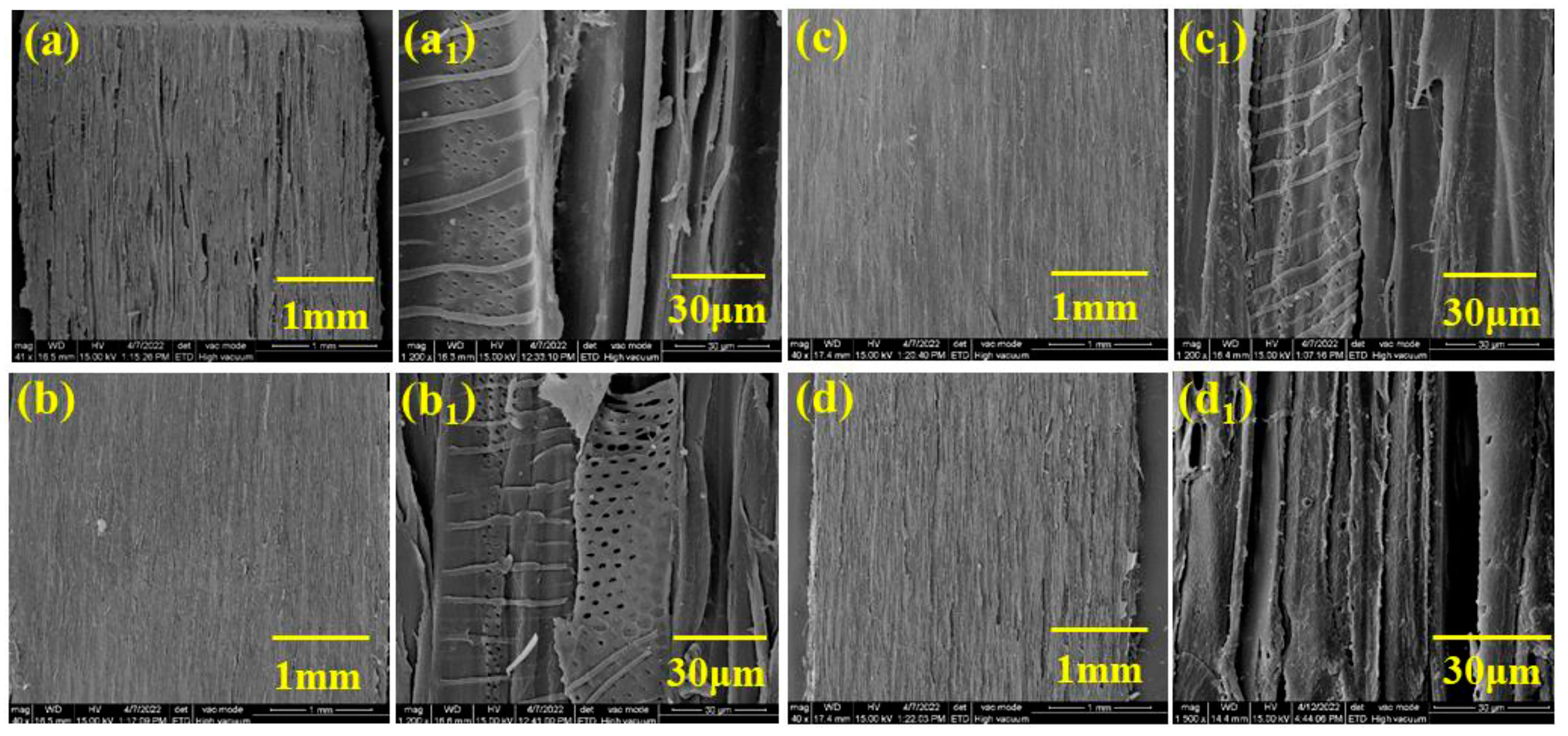

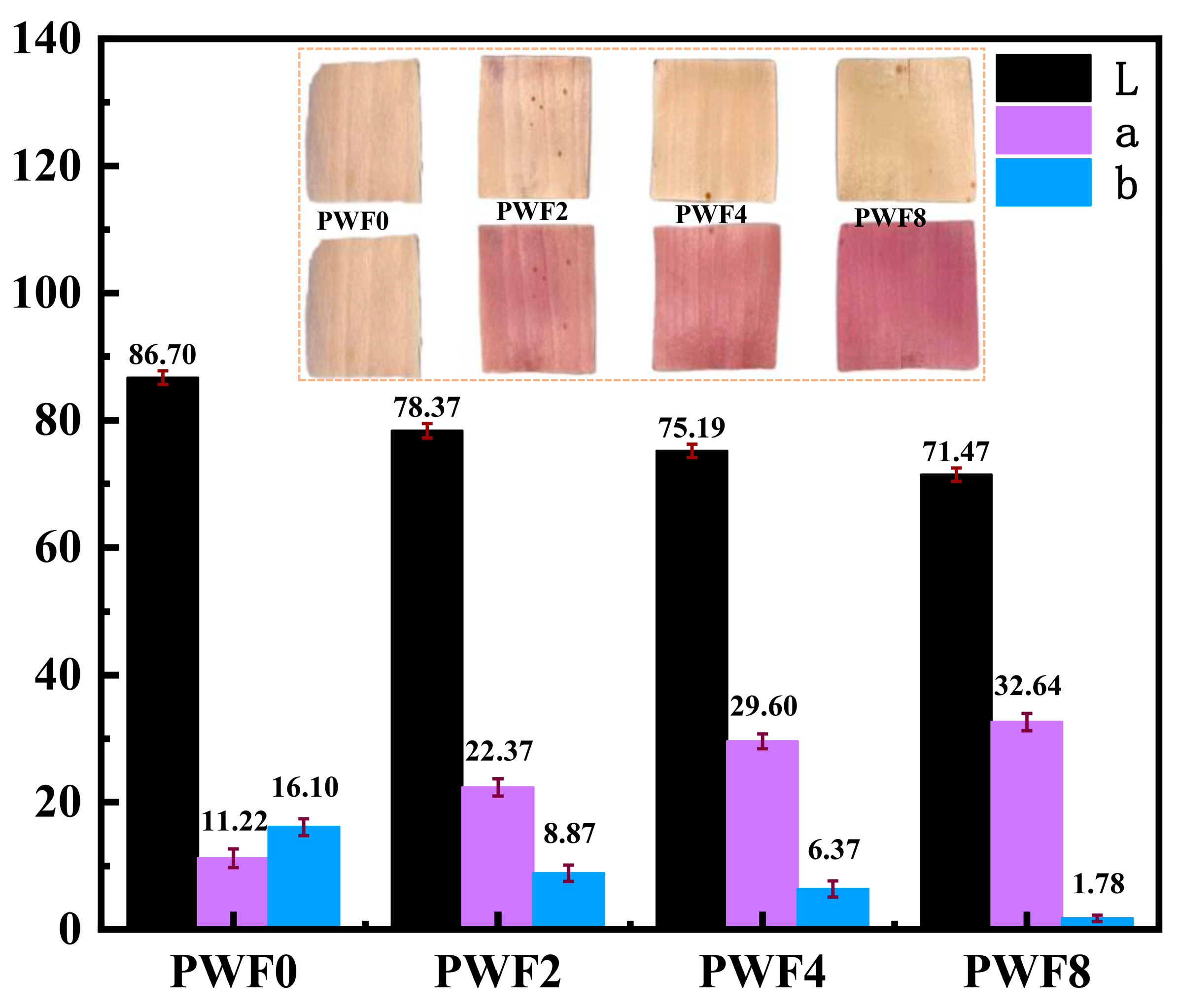
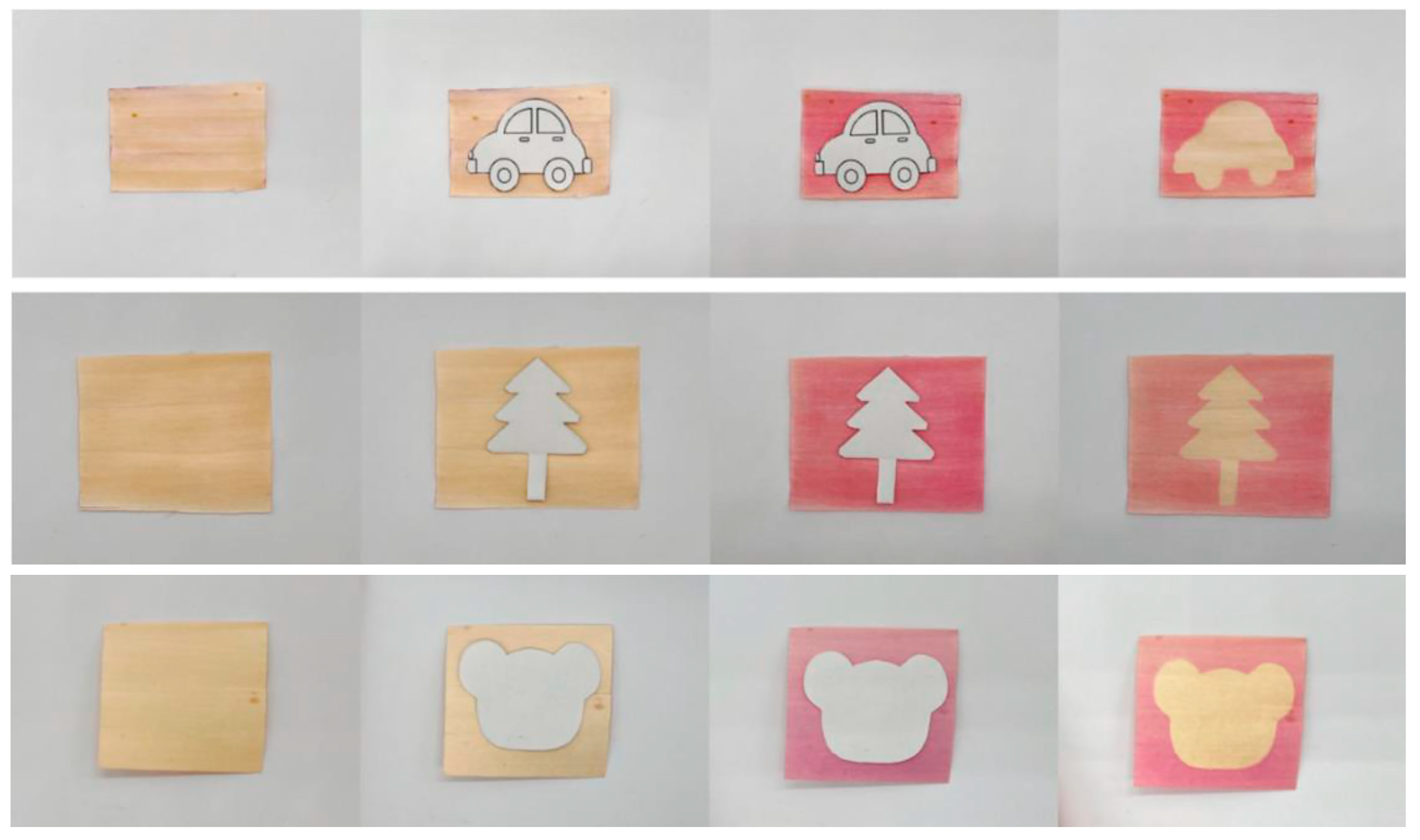
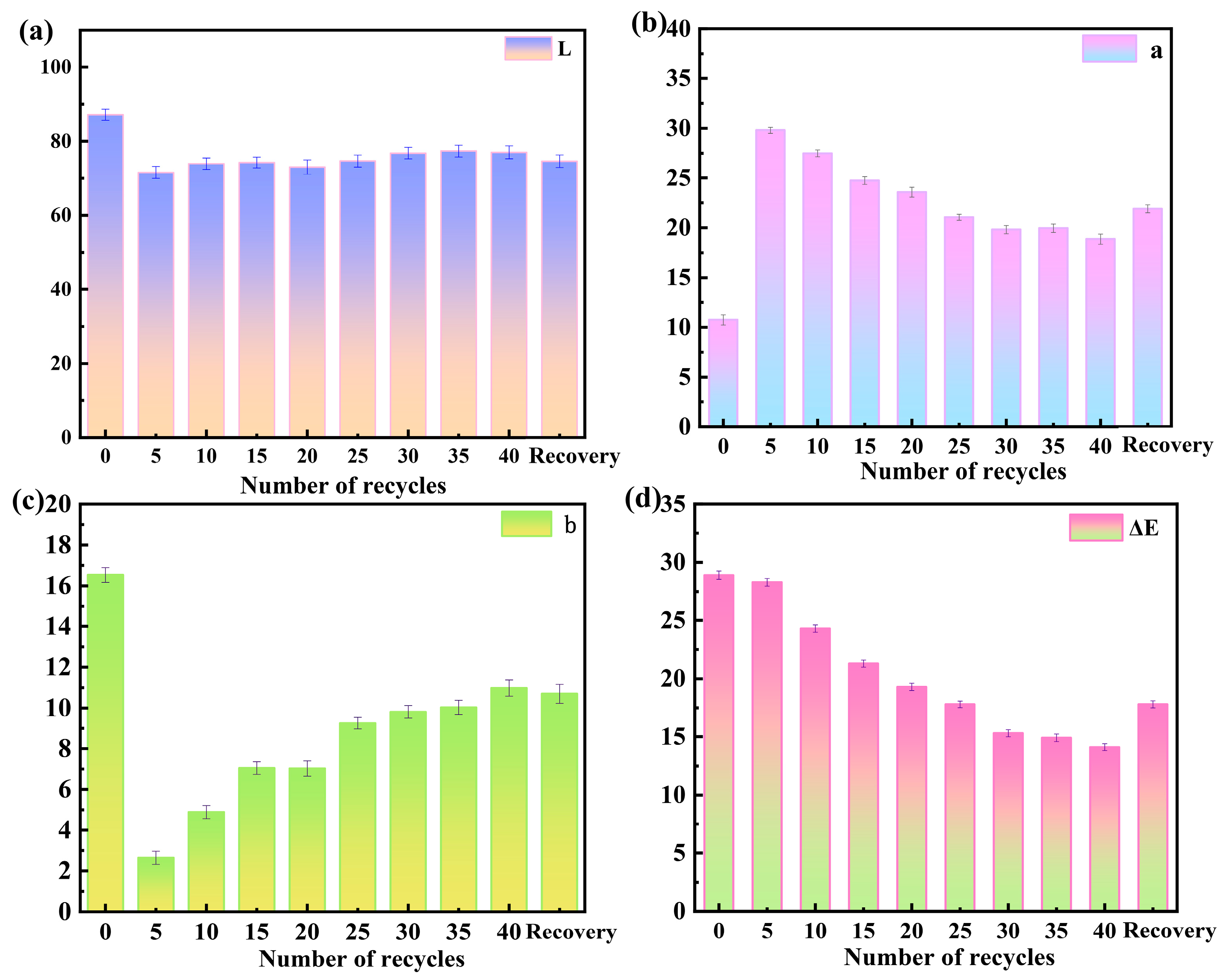
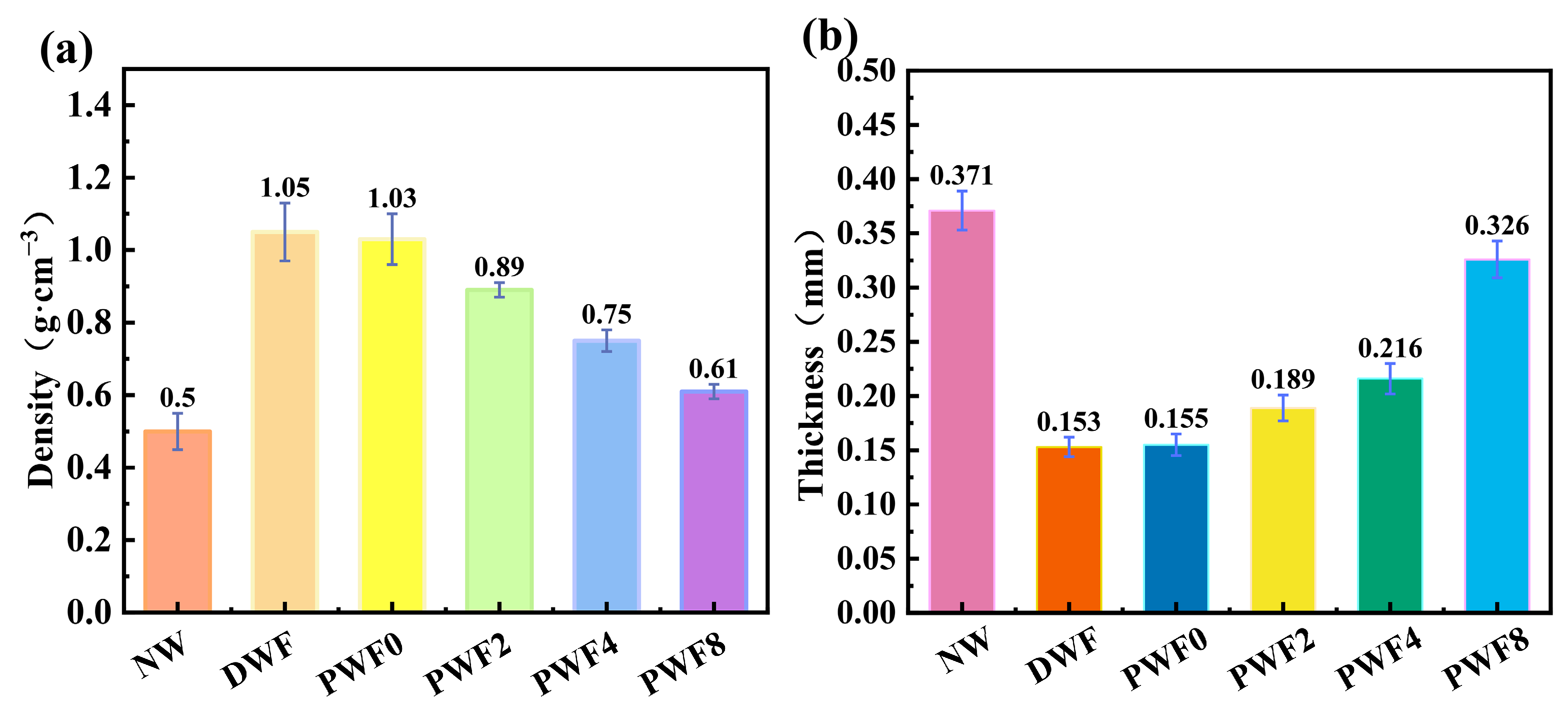
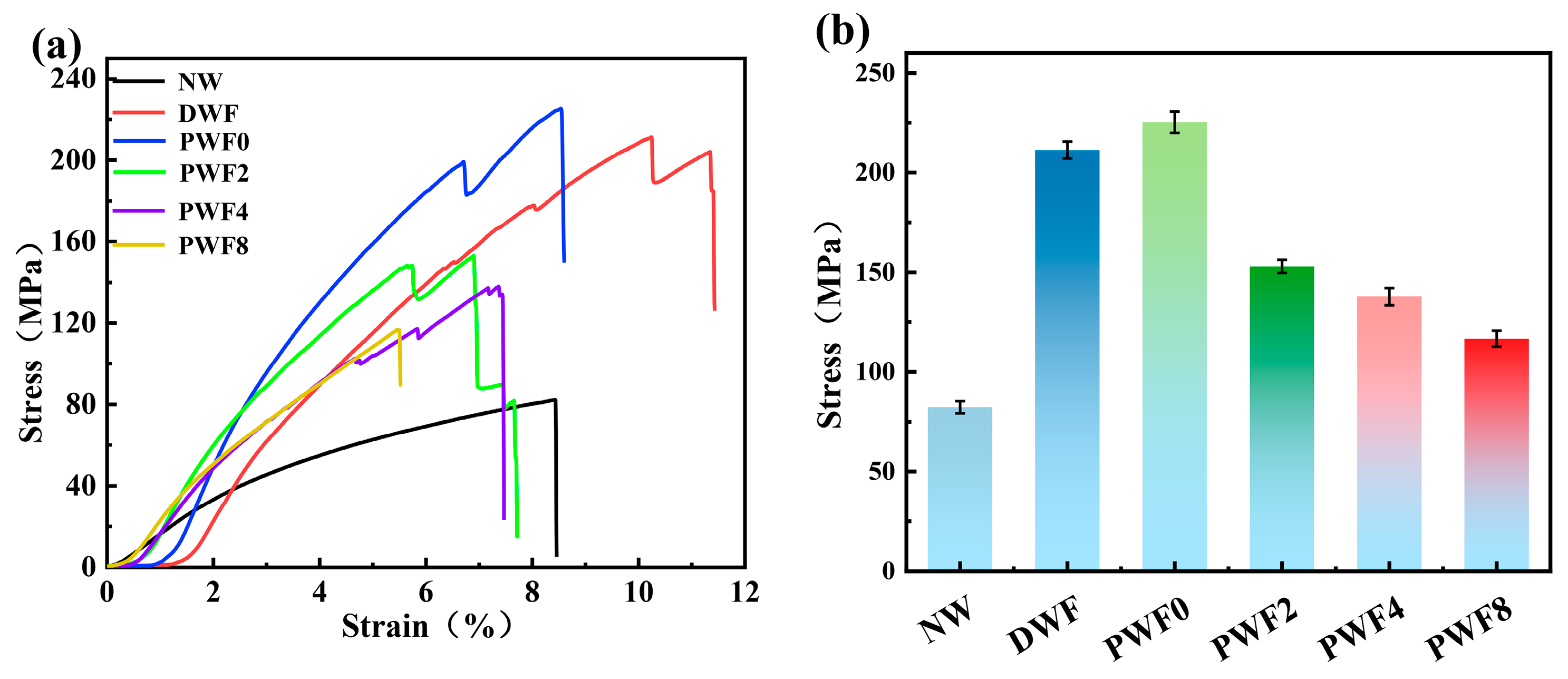
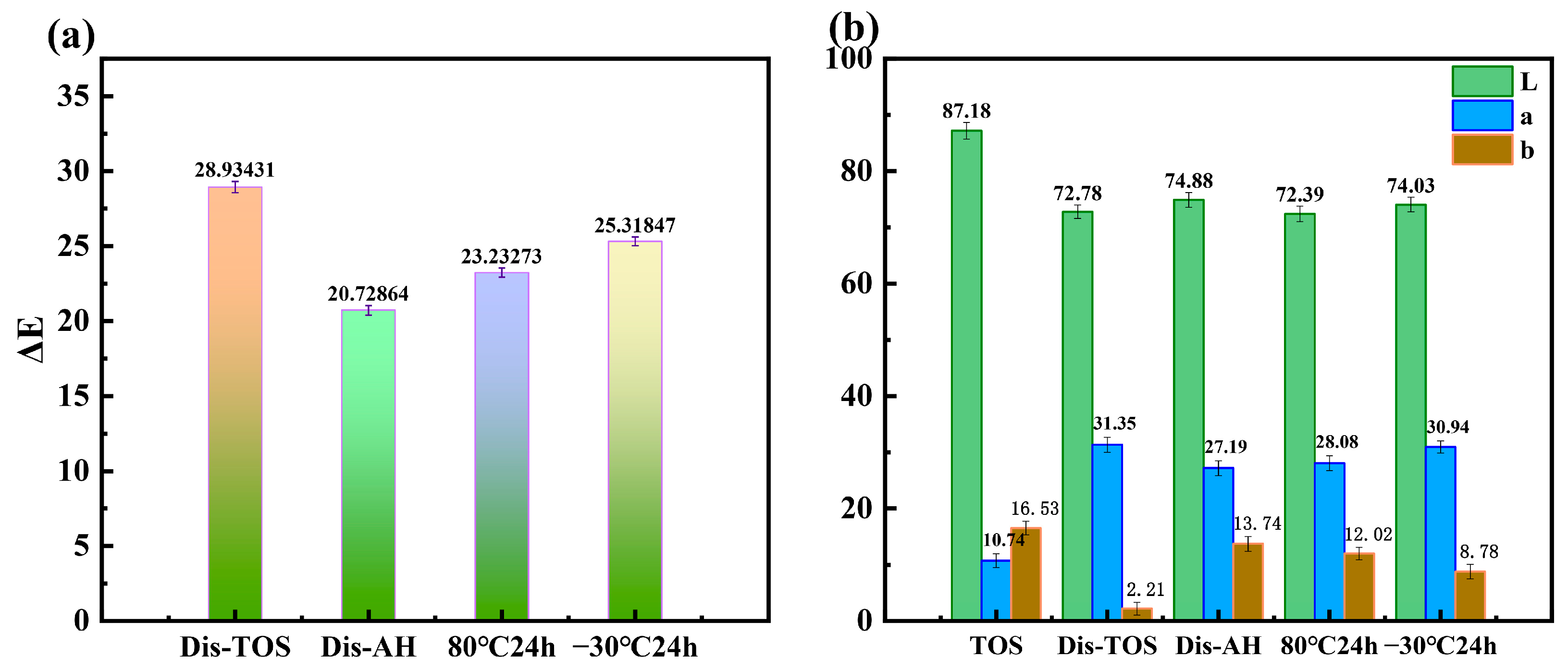
Disclaimer/Publisher’s Note: The statements, opinions and data contained in all publications are solely those of the individual author(s) and contributor(s) and not of MDPI and/or the editor(s). MDPI and/or the editor(s) disclaim responsibility for any injury to people or property resulting from any ideas, methods, instructions or products referred to in the content. |
© 2023 by the authors. Licensee MDPI, Basel, Switzerland. This article is an open access article distributed under the terms and conditions of the Creative Commons Attribution (CC BY) license (https://creativecommons.org/licenses/by/4.0/).
Share and Cite
Liu, X.; Xie, W.; Li, H.; Wang, K. Preparation of Photochromic Wood Films Comprising Spiropyran-Based Wood Cellulose Scaffold Realized through Grafting and Densification. Forests 2023, 14, 2018. https://doi.org/10.3390/f14102018
Liu X, Xie W, Li H, Wang K. Preparation of Photochromic Wood Films Comprising Spiropyran-Based Wood Cellulose Scaffold Realized through Grafting and Densification. Forests. 2023; 14(10):2018. https://doi.org/10.3390/f14102018
Chicago/Turabian StyleLiu, Xiaorong, Wenwen Xie, Hongji Li, and Kaili Wang. 2023. "Preparation of Photochromic Wood Films Comprising Spiropyran-Based Wood Cellulose Scaffold Realized through Grafting and Densification" Forests 14, no. 10: 2018. https://doi.org/10.3390/f14102018
APA StyleLiu, X., Xie, W., Li, H., & Wang, K. (2023). Preparation of Photochromic Wood Films Comprising Spiropyran-Based Wood Cellulose Scaffold Realized through Grafting and Densification. Forests, 14(10), 2018. https://doi.org/10.3390/f14102018





